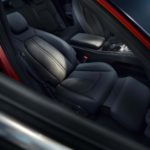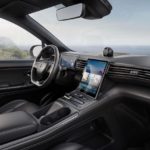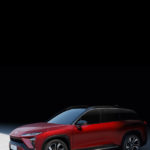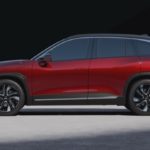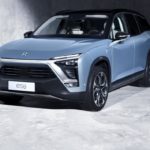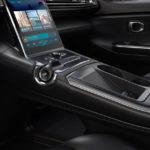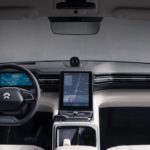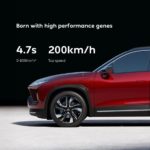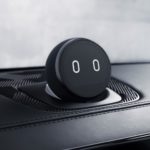
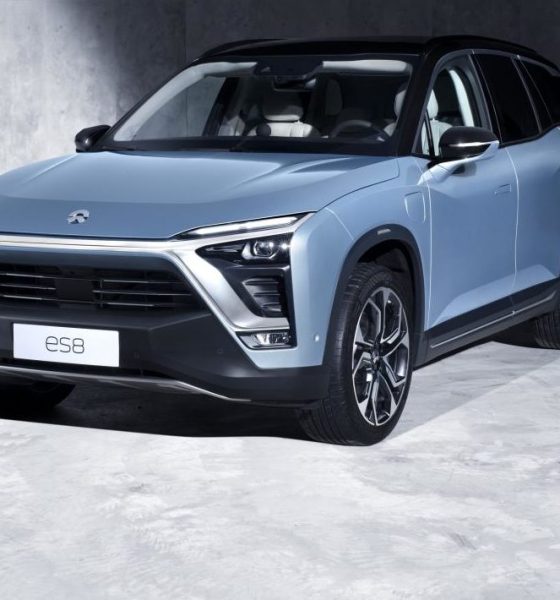
News
NIO sets its sights on overtaking Tesla in China
One of the latest electric car companies looking to challenge Tesla’s dominance has made known its intentions of overtaking the Silicon Valley car manufacturer in China’s luxury auto market. In a recent 60 Minutes interview, founder and CEO William Li described plans for NIO, his Chinese EV startup company to capture Tesla’s upper-middle class audience in the country, ultimately moving on to position its products as highly desired status symbols. With potentially 50% of the worldwide electric car market soon to be located in China, NIO’s ambitions are certainly poised in a promising direction, and their native knowledge of their customer market just may help give them the edge they’re seeking.
NIO’s strategy to appeal to the EV customer market is similar to Tesla’s in several ways and has earned it the nickname “Tesla of China.” The Chinese auto maker currently sells two high-performance SUVs, the ES6 and the ES8, both of which have an advanced autonomous driving system (not yet in operation) and an on-board pilot system. These, of course, are all features enjoyed by current Tesla drivers in Tesla’s own flavor, and with one look at NIO’s vehicles’ large center console control screen, it’s clear which auto maker’s customer base NIO is targeting. A phone app is incorporated into the NIO ownership experience, providing basic car services like roadside assistance and maintenance scheduling (as well as several other features). Customers can also purchase NIO vehicles via the app, similar to Tesla’s sales model. While significant commonalities exist between the two car makers, NIO has significant unique offerings as well.
- NIO’s ES6 electric SUV interior. | Credit: NIO
- NIO’s ES6 electric SUV command panel. | Credit: NIO
- NIO’s ES6 electric SUV. | Credit: NIO
- The NIO ES6 electric SUV. | Credit: NIO
- The NIO ES8 electric SUV. (Credit: NIO)
Owning a Tesla certainly comes with an incorporated sense of community, but NIO seeks to expand on that concept, eventually transforming its brand into a symbol of social standing by connecting customers with one another. The car maker presents itself as a lifestyle company, offering membership in exclusive NIO-owner-only clubs called NIO Houses with regular social activities and perks one might see at, say, a country or yacht club in the US – classes, meeting rooms, etc. The customer app also connects users to an entire social network of other owners – a bit beyond basic Internet forums.
NIO has further padded its ‘lifestyle’ perception with first-of-its-kind battery swapping technology, allowing customers to switch out their drained car batteries for fully charged ones via an automated system that’s faster than refueling at a gas station, saving time. Also, a mobile charging subscription service is an owner option, wherein NIO company vehicles travel to the vehicle’s location to supply it with power on request. Along with customer-oriented charging services and community perks, subscription packages offering free repairs and maintenance (with valet pickup/delivery options), cellular data boosts, car washing, airport parking, and several others all foster a lifestyle for NIO customers that’s only available via vehicle ownership.
For about $60,000 (before tax breaks and subsidies), a customer in China can own one of NIO’s two all-electric SUVs. The company’s flagship SUV, the ES8, is all-wheel drive, uses two 240 kW motors, and has a swappable 70 kWh/84 kWh battery. Impressively, it also has a 0-100 km/h (0-62 mph) time of 4.4 seconds. The newly released ES6 uses dual 160 kW high efficiency or 240 kW high performance motors with a swappable 70 kWh/84 kWh battery. The 0-100 km/h time is 4.7 seconds.
One of the major factors in NIO’s favor (as well as any electric car maker in the country) is the Chinese government’s major push to bring electric vehicles to the country’s roads. With air pollution a problem literally looming over the heads of major city populations, China’s leadership has maneuvered its tax system to provide major incentives for EV purchases to address the dirty air situation via clean energy. In Shanghai, for example, the $12,000+ license fee required to purchase a car in the city is waived if it’s electric. Additionally, several Chinese cities offer thousands of dollars in rebates for EV purchases.
Tesla CEO Elon Musk has experienced this motivated government favoritism first hand with a sped up permit and construction process for Gigafactory 3 in Shanghai. As an established EV maker and leader in the EV revolution, paving the way for Tesla to have a major presence in China is in line with the leadership’s desires for market transformation. As described in the 60 Minutes segment, hundreds of native electric vehicle companies have also popped up as a result of incentive efforts, all hoping to achieve major success with government backing. NIO hopes to cut through the competition with its lifestyle branding.
- NIO’s ES6 electric SUV command panel. | Credit: NIO
- NIO’s ES8 electric SUV command panel. | Credit: NIO
- NIO’s ES6 electric SUV. | Credit: NIO
- NIO’s AI personal assistant NOMI. | Credit: NIO
While Tesla may have entertainment features like TeslAtari and Easter eggs, NIO boasts its own unique fun feature: an artificial intelligence personal assistant named NOMI, touted by the company as the world’s first such in-car device. On the dashboard, a little sphere with digital eyes chats with vehicle passengers and interacts to provide music playlists, adjust cabin temperature, and even take selfies. NOMI seems to be inspired by other existing AI robot personal assistants like the personality-filled Vector Robot by Anki.
If you’re a fan of Amazon’s (hit) car show, The Grand Tour, you may have seen NIO’s EP9 supercar racer on display in the “Chinese Food for Thought” episode, driven by the crash-tested Richard Hammond demonstrating the car’s 1,341 brake horsepower. While not road legal, for the price of around $1.5 million dollars, owners of this insanely fast vehicle can enjoy a 0-125 mph acceleration of about 7 seconds and an octopus-like grip around track corners thanks to 5,395 pounds of downforce (2X the amount of Formula 1 cars). When it’s time to recharge the batteries, a full charge takes only 45 minutes; however, that’s where usability complications set in. The battery must be completely removed by a specialty team in order to recharge, something that just might be on hand to begin with since the vehicle is a track-only hobby car.
Last year, NIO achieved its goal of delivering 10,000 vehicles, all made-to-order. CEO Li expects to be able to ramp up production quickly in the coming years thanks to the Chinese manufacturing capabilities, and he eventually hopes to have NIO vehicles on the road in the United States. The company already has a presence in San Jose, California where its global software development center employs over 700 people.
In a final nod to Tesla similarities, NIO’s mission as an EV company is environmentally-involved. The Chinese name for the company is Weilai, meaning “Blue Sky Coming”, and it represents their guiding philosophy based on building a sustainable future with clean energy. Per their website, “When the ownership experience exceeds expectations, electric vehicles will simply become the natural choice for everyone, leading to a more sustainable tomorrow. With that, our vision of a blue sky will come true.”

Elon Musk
Tesla CEO Elon Musk teases insane capabilities of next major FSD update

Tesla CEO Elon Musk teased the insane capabilities of the next major Full Self-Driving update just hours after the company rolled out version 14.2 to owners.
Tesla Full Self-Driving v14.2 had some major improvements from the previous iteration of v14.1.x. We were on v14.1.7, the most advanced configuration of the v14.1 family, before Tesla transitioned us and others to v14.2.
However, Musk has said that the improvements coming in the next major update, which will be v14.3, will be where “the last big piece of the puzzle finally lands.”
14.3 is where the last big piece of the puzzle finally lands
— Elon Musk (@elonmusk) November 21, 2025
There were some major improvements with v14.2, most notably, Tesla seemed to narrow in on the triggers that caused issues with hesitation and brake stabbing in v14.1.x.
One of the most discussed issues with the past rollout was that of brake stabbing, where the vehicle would contemplate proceeding with a route as traffic was coming from other directions.
We experienced it most frequently at intersections, especially four-way stop signs.
Elon Musk hints at when Tesla can fix this FSD complaint with v14
In our review of it yesterday, it was evident that this issue had been resolved, at least to the extent that we had no issues with it in a 62-minute drive, which you can watch here.
Some owners also reported a more relaxed driver monitoring system, which is something Tesla said it was working on as it hopes to allow drivers to text during operation in the coming months. We did not test this, as laws in Pennsylvania prohibit the use of phones at any time due to the new Paul Miller’s Law, which took effect earlier this year.
However, the improvements indicate that Tesla is certainly headed toward a much more sentient FSD experience, so much so that Musk’s language seems to be more indicative of a more relaxed experience in terms of overall supervision from the driver, especially with v14.3.
Musk did not release or discuss a definitive timeline for the release of v14.3, especially as v14.2 just rolled out to Early Access Program (EAP) members yesterday. However, v14.1 rolled out to Tesla owners just a few weeks ago in late 2025. There is the potential that v14.3 could be part of the coming Holiday Update, or potentially in a release of its own before the New Year.
News
Tesla Full Self-Driving v14.2 – Full Review, the Good and the Bad

Tesla rolled out Full Self-Driving version 14.2 yesterday to members of the Early Access Program (EAP). Expectations were high, and Tesla surely delivered.
With the rollout of Tesla FSD v14.2, there were major benchmarks for improvement from the v14.1 suite, which spanned across seven improvements. Our final experience with v14.1 was with v14.1.7, and to be honest, things were good, but it felt like there were a handful of regressions from previous iterations.
While there were improvements in brake stabbing and hesitation, we did experience a few small interventions related to navigation and just overall performance. It was nothing major; there were no critical takeovers that required any major publicity, as they were more or less subjective things that I was not particularly comfortable with. Other drivers might have been more relaxed.
With v14.2 hitting our cars yesterday, there were a handful of things we truly noticed in terms of improvement, most notably the lack of brake stabbing and hesitation, a major complaint with v14.1.x.
However, in a 62-minute drive that was fully recorded, there were a lot of positives, and only one true complaint, which was something we haven’t had issues with in the past.
The Good
Lack of Brake Stabbing and Hesitation
Perhaps the most notable and publicized issue with v14.1.x was the presence of brake stabbing and hesitation. Arriving at intersections was particularly nerve-racking on the previous version simply because of this. At four-way stops, the car would not be assertive enough to take its turn, especially when other vehicles at the same intersection would inch forward or start to move.
This was a major problem.
However, there were no instances of this yesterday on our lengthy drive. It was much more assertive when arriving at these types of scenarios, but was also more patient when FSD knew it was not the car’s turn to proceed.
Can report on v14.2 today there were ZERO instances of break stabbing or hesitation at intersections today
It was a significant improvement from v14.1.x
— TESLARATI (@Teslarati) November 21, 2025
This improvement was the most noticeable throughout the drive, along with fixes in overall smoothness.
Speed Profiles Seem to Be More Reasonable
There were a handful of FSD v14 users who felt as if the loss of a Max Speed setting was a negative. However, these complaints will, in our opinion, begin to subside, especially as things have seemed to be refined quite nicely with v14.2.
Freeway driving is where this is especially noticeable. If it’s traveling too slow, just switch to a faster profile. If it’s too fast, switch to a slower profile. However, the speeds seem to be much more defined with each Speed Profile, which is something that I really find to be a huge advantage. Previously, you could tell the difference in speeds, but not in driving styles. At times, Standard felt a lot like Hurry. Now, you can clearly tell the difference between the two.
It seems as if Tesla made a goal that drivers should be able to tell which Speed Profile is active if it was not shown on the screen. With v14.1.x, this was not necessarily something that could be done. With v14.2, if someone tested me on which Speed Profile was being used, I’m fairly certain I could pick each one.
Better Overall Operation
I felt, at times, especially with v14.1.7, there were some jerky movements. Nothing that was super alarming, but there were times when things just felt a little more finicky than others.
v14.2 feels much smoother overall, with really great decision-making, lane changes that feel second nature, and a great speed of travel. It was a very comfortable ride.
The Bad
Parking
It feels as if there was a slight regression in parking quality, as both times v14.2 pulled into parking spots, I would have felt compelled to adjust manually if I were staying at my destinations. For the sake of testing, at my first destination, I arrived, allowed the car to park, and then left. At the tail-end of testing, I walked inside the store that FSD v14.2 drove me to, so I had to adjust the parking manually.
This was pretty disappointing. Apart from parking at Superchargers, which is always flawless, parking performance is something that needs some attention. The release notes for v14.2. state that parking spot selection and parking quality will improve with future versions.
Any issues with parking on your end? 14.1.7 didn’t have this trouble with parking pic.twitter.com/JPLRO2obUj
— TESLARATI (@Teslarati) November 21, 2025
However, this was truly my only complaint about v14.2.
You can check out our full 62-minute ride-along below:
Elon Musk
SpaceX issues statement on Starship V3 Booster 18 anomaly
The incident unfolded during gas-system pressure testing at the company’s Massey facility in Starbase, Texas.

SpaceX has issued an initial statement about Starship Booster 18’s anomaly early Friday. The incident unfolded during gas-system pressure testing at the company’s Massey facility in Starbase, Texas.
SpaceX’s initial comment
As per SpaceX in a post on its official account on social media platform X, Booster 18 was undergoing gas system pressure tests when the anomaly happened. Despite the nature of the incident, the company emphasized that no propellant was loaded, no engines were installed, and personnel were kept at a safe distance from the booster, resulting in zero injuries.
“Booster 18 suffered an anomaly during gas system pressure testing that we were conducting in advance of structural proof testing. No propellant was on the vehicle, and engines were not yet installed. The teams need time to investigate before we are confident of the cause. No one was injured as we maintain a safe distance for personnel during this type of testing. The site remains clear and we are working plans to safely reenter the site,” SpaceX wrote in its post on X.
Incident and aftermath
Livestream footage from LabPadre showed Booster 18’s lower half crumpling around the liquid oxygen tank area at approximately 4:04 a.m. CT. Subsequent images posted by on-site observers revealed extensive deformation across the booster’s lower structure. Needless to say, spaceflight observers have noted that Booster 18 would likely be a complete loss due to its anomaly.
Booster 18 had rolled out only a day earlier and was one of the first vehicles in the Starship V3 program. The V3 series incorporates structural reinforcements and reliability upgrades intended to prepare Starship for rapid-reuse testing and eventual tower-catch operations. Elon Musk has been optimistic about Starship V3, previously noting on X that the spacecraft might be able to complete initial missions to Mars.
